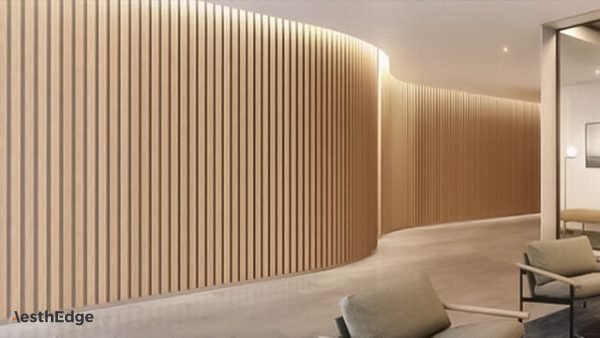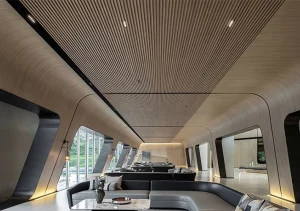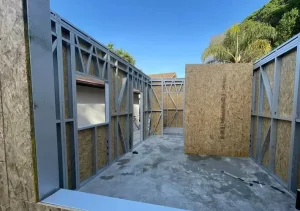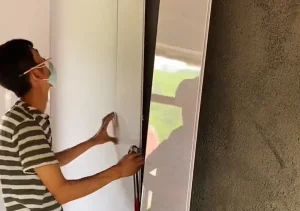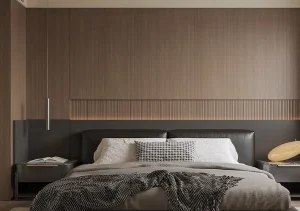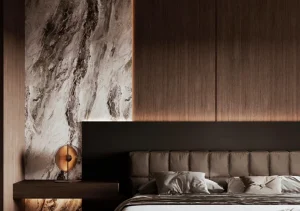In recent years, WPC (Wood Plastic Composite) ceiling panels have become an increasingly popular choice in the world of interior design and construction. Known for their durability, aesthetic appeal, and eco-friendly composition, these panels offer a versatile and practical solution for various settings, from residential to commercial spaces. This article will delve into the characteristics, benefits, and applications of WPC ceiling panels, providing you with a comprehensive understanding of this innovative material.

Table of Contents
ToggleWhat are WPC Ceiling Panels?
WPC ceiling panels are made from a blend of wood fibers and plastic materials, often combined with additives to enhance performance. This hybrid composition results in a material that combines the natural appearance of wood with the durability and ease of maintenance associated with plastic. Typically manufactured through extrusion or molding processes, WPC ceiling panels can be customized in terms of color, texture, and dimensions to meet diverse aesthetic and functional needs.
Advantages of WPC Ceiling Panels
WPC ceiling panels come with numerous advantages that set them apart from traditional ceiling materials. Below are some of the most prominent benefits:
1.Durability and Longevity
- WPC panels are highly resistant to moisture, humidity, and temperature fluctuations, making them suitable for both indoor and outdoor use. They are less prone to warping, cracking, or rotting, ensuring a long lifespan even in challenging environments.
2.Eco-Friendly Composition
- As a composite material, WPC utilizes recycled wood fibers and plastics, reducing the demand for virgin materials and minimizing waste. Many manufacturers use sustainable sources, which makes WPC a more environmentally friendly option compared to pure wood or plastic.
3.Low Maintenance
- Unlike wood, which requires regular treatment, sealing, or painting, WPC ceiling panels are low maintenance. They resist stains and are easy to clean, saving time and effort in upkeep.
4.Fire and Pest Resistance
- WPC ceiling panels are typically treated to enhance fire resistance, adding an extra layer of safety. Additionally, their synthetic content makes them naturally resistant to termites and other wood-boring pests.
5. Aesthetic Flexibility
- With WPC panels, you can achieve the warm, natural look of wood or a sleek, modern appearance depending on the design. They are available in a wide range of colors, finishes, and patterns, allowing for customization to match any interior style.
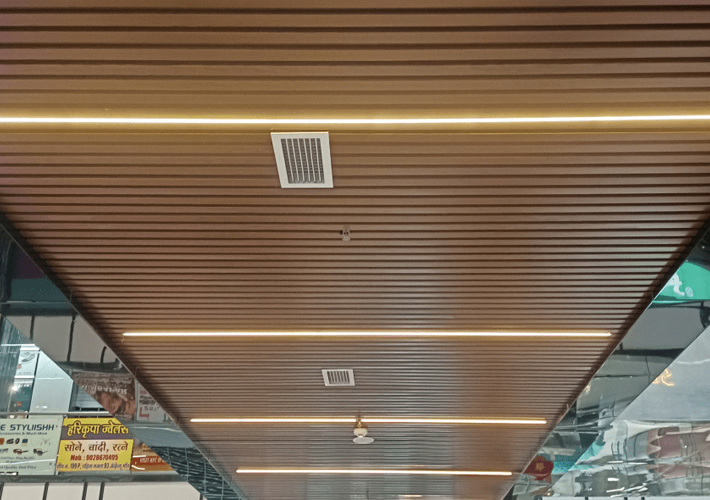
Types of WPC Ceiling Panels
WPC ceiling panels come in several types, each suited for different applications:
1.Flat Panels
- These panels offer a smooth, even surface, ideal for minimalistic or modern designs. They are often used in commercial settings where a clean, professional look is desired.
2.Textured or Embossed Panels
- Textured panels mimic the appearance of wood grain, stone, or other natural materials, adding depth and character to a space. They are popular in residential interiors where a touch of warmth is sought.
3.Perforated Panels
- Perforated WPC panels are designed for acoustic purposes, making them ideal for spaces that require sound absorption, such as conference rooms, theaters, or music studios.
4.Customizable Panels
- Many manufacturers offer customizable options, allowing clients to specify dimensions, colors, and finishes that align with unique design requirements.
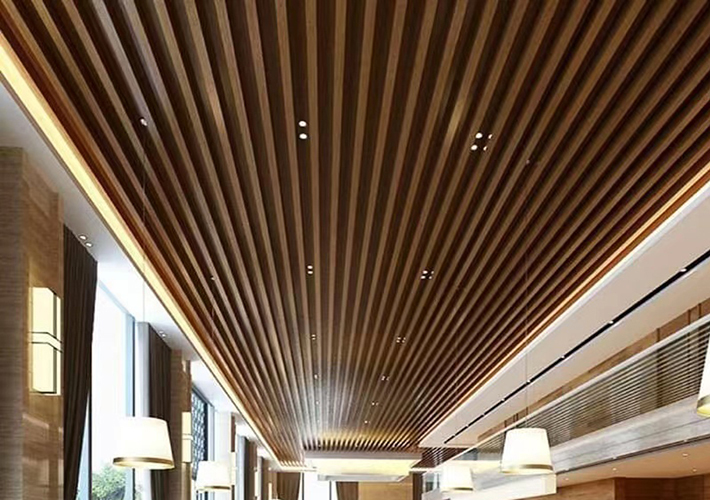
Applications of WPC Ceiling Panels
Thanks to their versatility and durability, WPC ceiling panels are used in a wide range of environments:
1.Residential Spaces
- In homes, WPC ceiling panels are ideal for living rooms, bedrooms, and kitchens, providing a modern, stylish ceiling option that requires little maintenance. They are particularly suited for areas prone to moisture, such as bathrooms.
2.Commercial Settings
- Office buildings, restaurants, and retail stores benefit from the professional, polished look of WPC panels. The acoustic properties of certain WPC designs also make them popular in conference rooms and auditoriums.
3.Outdoor and Semi-Outdoor Areas
- Due to their weather resistance, WPC ceiling panels are suitable for patios, balconies, and outdoor lounges, creating a cohesive indoor-outdoor aesthetic.
4.Educational and Healthcare Facilities
- In schools, hospitals, and other facilities where cleanliness and durability are key, WPC ceiling panels provide a practical solution. Their fire resistance and ease of maintenance add to their suitability for these environments.
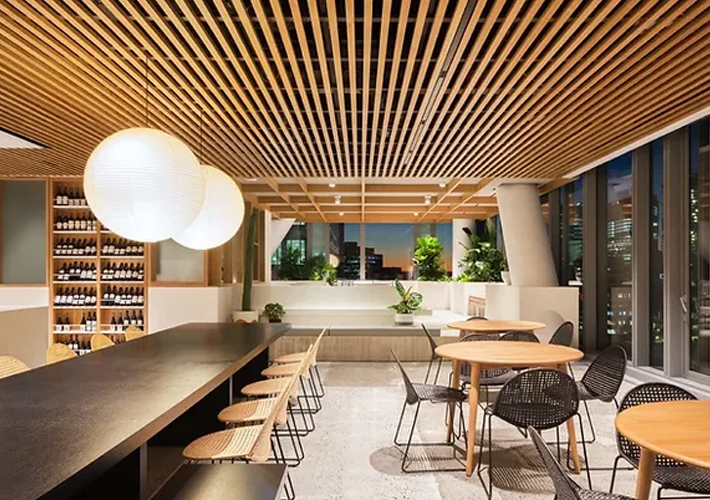
Installation Process of WPC Ceiling Panels
Installing WPC ceiling panels is generally straightforward, involving a few simple steps that can be completed by professionals or DIY enthusiasts. Here is an outline of the installation process:
1.Preparing the Surface
- Ensure the ceiling surface is clean and dry. Any irregularities should be leveled out to ensure a smooth installation.
2.Setting Up the Framework
- A wooden or metal framework is usually installed first to support the panels. This frame acts as a secure base for the WPC panels to be attached.
3.Attaching the Panels
- WPC panels are affixed to the framework using screws, adhesives, or interlocking systems, depending on the design. It’s important to follow the manufacturer’s guidelines for spacing to accommodate expansion and contraction.
4.Finishing Touches
- After all panels are in place, trim pieces are often added to cover edges and corners, giving the ceiling a polished appearance.
Cost Considerations
The cost of WPC ceiling panels varies based on factors like panel thickness, finish, and brand. Generally, WPC panels offer a cost-effective alternative to traditional wood or metal ceilings due to their durability and low maintenance requirements. When calculating the overall cost, consider factors such as installation, any necessary framing materials, and maintenance savings over time.
Future Trends in WPC Ceiling Panels
With the global demand for sustainable building materials rising, the future of WPC ceiling panels looks promising. Here are some key trends expected to shape the industry:
1.Sustainable Manufacturing Practices
- As more consumers and businesses prioritize eco-friendly options, manufacturers are adopting greener production methods, such as using recycled content and reducing energy consumption.
2.Technological Innovations
- Advances in WPC technology are leading to improved performance characteristics, such as enhanced durability, fire resistance, and color retention.
3.Integration with Smart Home Systems
- Future WPC panels may feature integrated lighting, sound systems, or climate control capabilities, blending aesthetics with functionality in smart home environments.
4.Expanding Customization Options
- With a growing emphasis on personalized interiors, manufacturers are offering more customization options, from unique textures and colors to innovative installation systems.
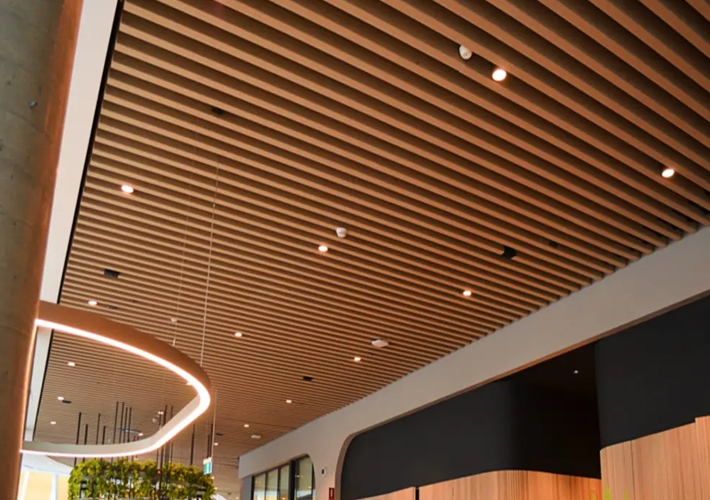
Conclusion
WPC ceiling panels offer a modern, eco-friendly alternative to traditional ceiling materials, suitable for various environments and design preferences. Their durability, aesthetic appeal, and minimal maintenance requirements make them a smart choice for both residential and commercial projects. As sustainability and technological innovations continue to shape the industry, WPC ceiling panels are poised to remain a popular and adaptable choice in interior design.
Whether you’re looking to enhance a residential space, create a professional office environment, or design a trendy restaurant, WPC ceiling panels provide an appealing and practical solution that meets modern standards. Explore the possibilities with WPC ceiling panels and discover how they can transform your space with minimal effort and long-lasting results.

